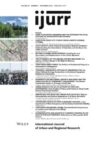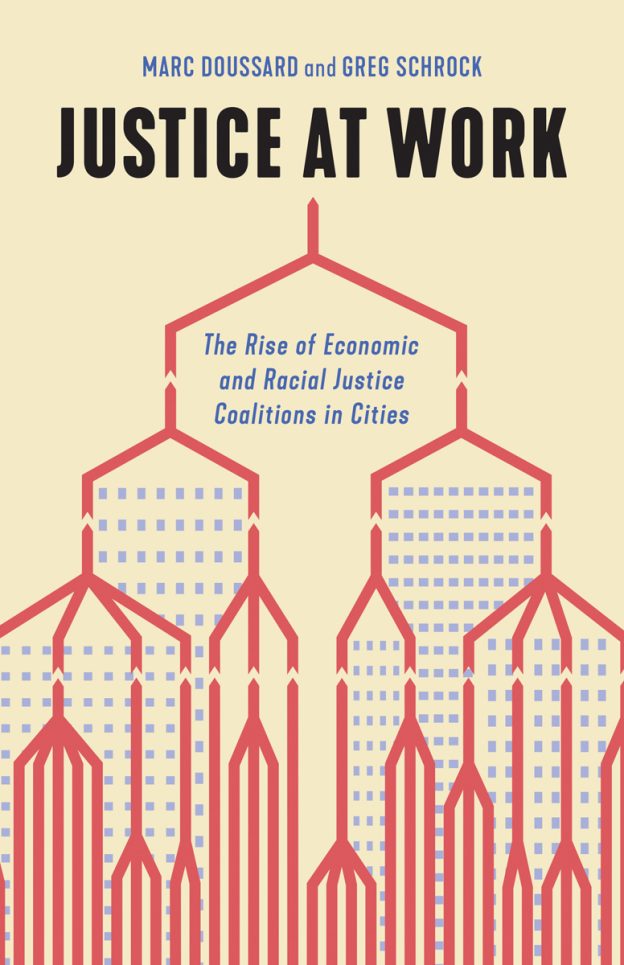Marc Doussard and Greg Schrock’s Justice at Work is an informative and readable book about activism in contemporary US cities. Economic and racial justice (ERJ) coalitions—’networks of unions, community organizations, and advocacy groups who push for policy interventions against economic inequality as part of a broader goal of addressing … racial inequalities’ (p. 35)—are the latest iteration of movements aimed at tackling the problems associated with urban renewal. Like their predecessors in the living wage and community benefit agreement movements, ERJ coalitions aim to redistribute the gains from urban renewal to poor communities and people of color.
The book makes some important advances for urban studies. One is the focus on social movements rather than elected officials and city bureaucracies; another is the much-needed shift from focusing on individual cities to looking instead at the networks that span between them. The cities featured in this study are not treated as independent units being compared in the name of causal analysis. Instead, the authors show how ‘urban policy entrepreneurs’ active in ERJ coalitions learn from experiments in other cities and states and adapt them to local contexts. Chapters 4 to 7 provide the empirical heart of the book, with each chapter devoted to a specific policy area. Examining ERJ coalitions in Chicago, St. Louis, Indianapolis, Denver, Portland, Seattle, New Orleans and elsewhere, the authors demonstrate how policy entrepreneurs have framed the problems, identified leverage points and bargaining strategies, and fashioned appropriate policies.
Taken as a whole, there are several important takeaways. First, activists use the city itself as leverage, by capitalizing on the fact that many growing industries are ‘place-attached’ and not prone to capital flight (p. 60). Second, unlike predecessor movements that emphasized either economic or racial justice frames, the authors argue that ERJ coalitions often keep race in the foreground, with significant payoffs. Finally, while the coalitions have an expansive focus, including the bread-and-butter issue of a higher minimum wage, they also raise issues concerning who receives good jobs (targeted hiring), social reproduction (fair workweek and paid time off), and access to city resources such as good schools (anti-austerity).
There is of course some variation among the cities featured and the issues tackled. The simplicity of the call for a higher minimum wage meant that this policy was easily diffused to other locations after its early successes. Later minimum wage campaigns ‘consumed progressively fewer resources, took less time, and faced small odds of failing’ (p. 106), even in cities with far less favorable starting conditions. Similarly, policy entrepreneurs seeking to ensure that jobs associated with public projects go to local hires in New Orleans and Seattle were able to clearly tie racial justice frames to calls for local hiring, even though they had their work cut out tailoring policy solutions to fit their complex local environments. In contrast, activists found it difficult to frame fair workweek policies that would address exploitative scheduling practices effectively (although it was not immediately clear to me why activists working in this area were unsuccessful in applying racial justice frames). Nevertheless, they have achieved some limited success thanks to their sway over elected officials and the availability of model legislation within the network. Finally, anti-austerity activists have been successful in tying questions of public finance to racial justice in ways that parallel the case of targeted hiring (p. 182).
I learned a lot from this book and appreciated the clear writing and ambitious scope. The authors skillfully tie together insights from urban, labor and social movement studies and political science. The interview data from activists is engaging and illuminates how activists learn from past efforts in their own jurisdictions and look to others within their networks. I can imagine that Justice at Work will provide pragmatic lessons for activists.
However, the book also raises various questions, as any strong piece of scholarship should. I am curious about public awareness of policy outcomes. This is not just a question about enforcement, as it goes beyond that to broader notions of policy feedback. As the authors note, reforms associated with the Fordist economy—and especially the right to unionize—spurred significant positive feedback effects. The unions’ gains for the working class led to advantages for the Democrats at the ballot box, which facilitated more reforms for working people. Is anything of that sort happening here as well? In other words, do the residents of these cities perceive that they have benefited from the work of these coalitions? If not, does that raise questions about the durability of the coalitions and the policies themselves?
Relatedly, the authors are careful to avoid an overly triumphant tone and describe several threats to the continued success of ERJ coalitions in the conclusion. Nonetheless, the overall tone of the book is optimistic, and for good reason. I agree with the authors that ignoring the progress of ERJ coalitions results in an impoverished understanding of urban politics. However, I read this book after the 2024 elections, and I cannot deny that this timing influenced my thinking on it. On the one hand, the presence of such coalitions is likely important for the legal and activist pushbacks against the policies of the Trump administration. On the other hand, if post-election coverage of voting trends has it right, then some of the cities featured in this book experienced significant rightward shifts, seemingly due to concerns about affordability, disorder and immigration. Is it possible that despite their good work, ERJ coalitions have had insufficient impact in improving the lives of working Americans of all stripes and hence failed to fend off a rightward lurch?
Jessica Garrick, University of Denver
Marc Doussard and Greg Schrock 2022: Justice at Work: The Rise of Economic and Racial Justice Coalitions in Cities. Minneapolis, MN: University of Minnesota Press.
Views expressed in this section are independent and do not represent the opinion of the editors.

